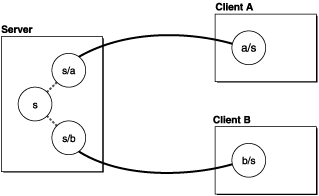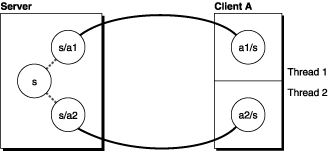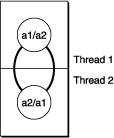Retired Document
Important: This document may not represent best practices for current development. Links to downloads and other resources may no longer be valid.
For interprocess communication, you should use XPC instead; see XPC Services API Reference for more information.
Connections and Proxies
This section describes the highest level components of the distributed objects system: the object that manages the communication (NSConnection) and the two proxy objects that stand in for the vended object (NSDistantObject and NSProtocolChecker).
NSConnection
NSConnection objects manage communication between objects in different threads or tasks, on a single host or over the network. They form the backbone of the distributed objects mechanism, and normally operate in the background. You use NSConnection API explicitly when making an object available to other applications, when accessing such a vended object, and when altering default communication parameters; the rest of the time you simply interact with the distributed objects themselves.
NSConnection objects work in pairs, one in each communicating application or thread. A server application has an NSConnection object for every client application connected to it, as shown in Figure 1 (the connection labeled s is used to form new connections, as described in Vending an Object and Getting a Vended Object). The circles represent NSConnection objects, and the labels indicate the application itself and the application it is connected to. For example, in s/a the s stands for the server and the a stands for client A. If a link is formed between clients A and B in this example, two new NSConnection objects get created: a/b and b/a.

Under normal circumstances, all distributed objects passed between applications are tied through one pair of NSConnection objects. NSConnection objects cannot be shared by separate threads, though, so for multithreaded applications a separate NSConnection object must be created for each thread. This is shown in Figure 2.

Finally, an application can use distributed objects between its own threads to make sending messages thread-safe. This is useful for coordinating work with the Application Kit, for example. Figure 3 shows how the NSConnection objects are connected. (Note that every thread has its own default NSConnection object with which it can vend a single object.) See Communicating With Distributed Objects for more details.

NSProxy and Subclasses
NSProxy is an abstract superclass defining an API for objects that act as stand-ins for other objects or for objects that don’t exist yet. Typically, a message to a proxy is forwarded to the real object, or causes the proxy to load (or transform itself into) the real object. Subclasses of NSProxy can be used to implement transparent distributed messaging (for example, NSDistantObject) or for lazy instantiation of objects that are expensive to create.
There are two subclasses of NSProxy defined by the distributed objects system. NSDistantObject represents the vended object on the client system; it captures messages passed to it and forwards them using an NSConnection object to the server process. An NSProtocolChecker object can be vended by the server process instead of the real object to filter out any messages that do not conform to a particular protocol. More details of each class are below.
NSDistantObject
NSDistantObject is a concrete subclass of NSProxy that defines proxies for objects in other applications or threads. When an NSDistantObject object receives a message, in most cases it forwards the message through its NSConnection object to the real object in another application, supplying the return value to the sender of the message if one is forthcoming, and propagating any exception back to the invoker of the method that raised it.
NSDistantObject adds two useful instance methods to those defined by NSProxy. connectionForProxy returns the NSConnection object that handles the receiver. setProtocolForProxy: establishes the set of methods the real object is known to respond to, saving the network traffic required to determine the argument and return types the first time a particular selector is forwarded to the remote proxy. Setting a protocol, though, does not prevent other methods from being sent; they just require network traffic to obtain the method signature. To filter out methods not in the protocol, use an NSProtocolChecker instance as the vended object.
There are two kinds of NSDistantObject: local proxies and remote proxies. A local proxy is created by an NSConnection object the first time an object is sent to another application. It is used by the NSConnection object for bookkeeping purposes and should be considered private. The local proxy is transmitted over the network using the NSCoding protocol to create the remote proxy, which is the object that the other application uses. NSDistantObject defines methods for an NSConnection object to create instances, but they are intended only for subclasses to override—you should never invoke them directly. Use NSConnection’s rootProxyForConnectionWithRegisteredName:host: method, which sets up all the required state for an object-proxy pair.
NSProtocolChecker
When an object is vended, all of its methods become available to other processes. This may not be desired when vending an object with many methods, only a few of which ought to be remotely accessible. The NSProtocolChecker class (a concrete subclass of NSProxy) defines an object that restricts the messages that can be sent to another object (referred to as the checker’s delegate).
A protocol checker acts as a kind of proxy; when it receives a message that is in its designated protocol, it forwards the message to its target, and consequently appears to be the target object itself. However, when it receives a message not in its protocol, it raises an NSInvalidArgumentException to indicate that the message is not allowed, whether or not the target object implements the method.
Typically, an object that is to be distributed (yet must restrict messages) creates an NSProtocolChecker object for itself and returns the checker rather than returning itself in response to any messages. The object might also register the checker as the root object of an NSConnection.
The object should be careful about vending references to self—the protocol checker converts a return value of self to indicate the checker rather than the object for any messages forwarded by the checker, but direct references to the object (bypassing the checker) could be passed around by other objects.
Copyright © 2003, 2017 Apple Inc. All Rights Reserved. Terms of Use | Privacy Policy | Updated: 2017-06-07